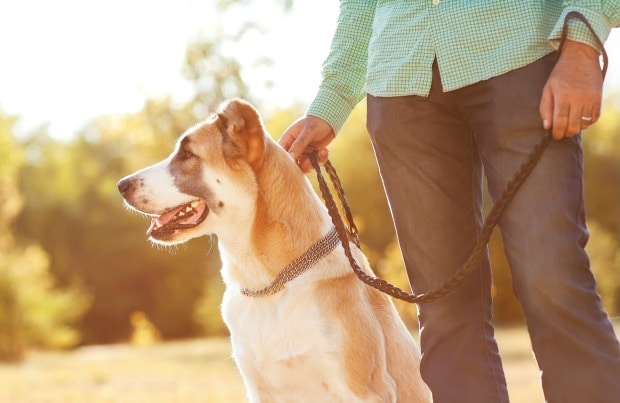When the temperatures drop and the snowflakes start flying, you might be tempted to curl up under a blanket on your couch—until you see your dog standing by the door, begging for some playtime in the fresh air. (We swear they could practically melt the doorknob with their longing gaze!) Here’s the good news: Even when it’s cold outside, there are plenty of winter dog sports and activities that’ll get you both outside for some dog-friendly fun together.
To help you choose the best activity for you and your dog, we’ve gathered a list of suggestions for everyone from athletic adventurers to snow day newbies. We’ve rated each one on a difficulty scale of 1-5, with 5 being the most difficult, based on the level of training and exertion required for both you and your dog. Plus, we’ve explained what types of dogs are especially suited to each.
But before you rush outside, remember that not all dogs are built for hours of playtime in the snow. Toy breeds, young puppies, and fragile old dogs should generally not play outside when temps drop to 20 degrees or below, and other dogs may need shorter play sessions, boots or a coat. (We love this highly-rated dog puffer coat from Frisco because of its water-resistant shell, cozy fleece lining and how easy it is to put on and take off.) Find out how to keep your dog safe in winter weather, and contact your veterinarian with any questions.
Click the buttons below to jump to each sport
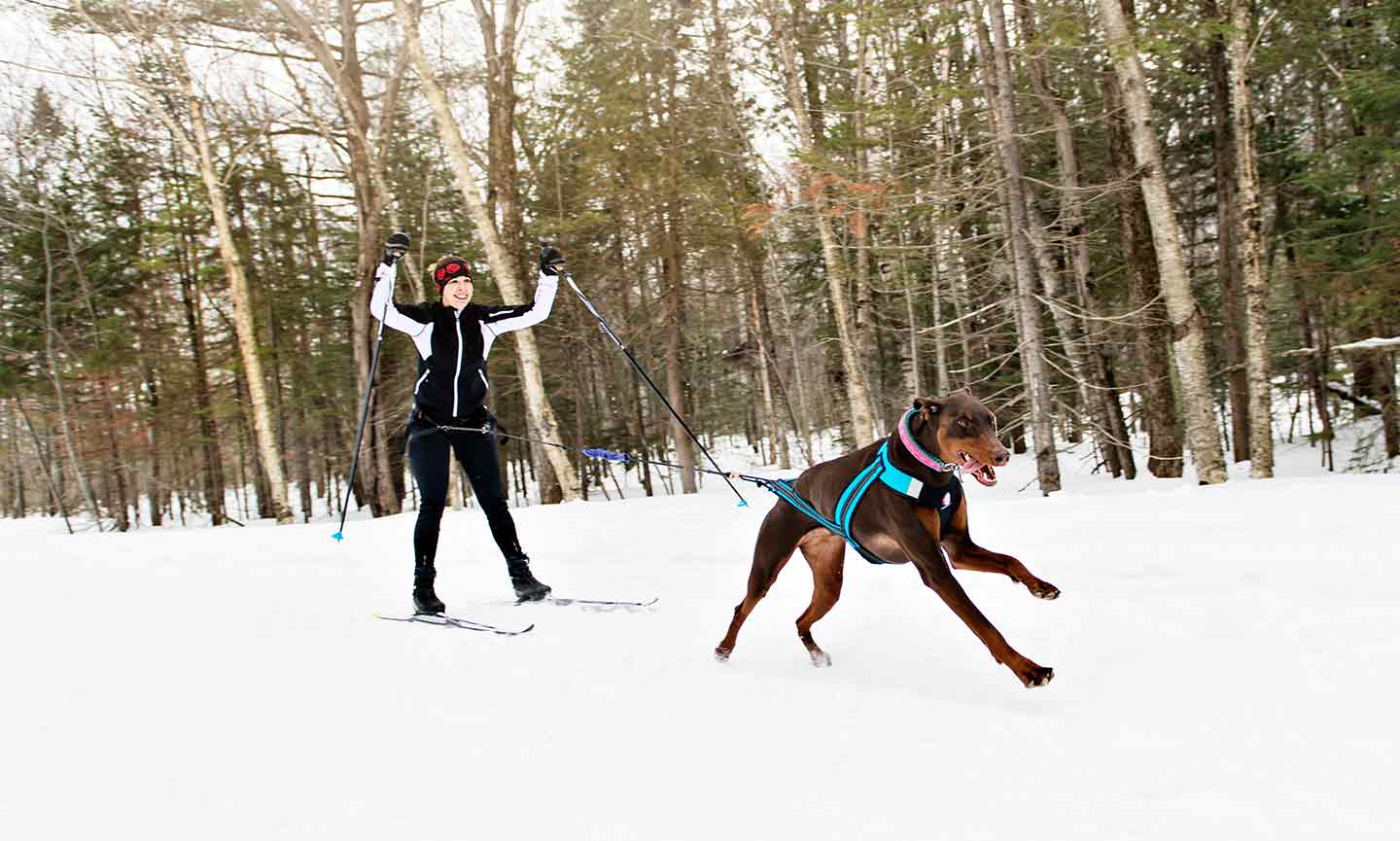
1 Skijoring
- Difficulty: 5 (most difficult)
- Best for: Well-trained dogs with lots of energy
When it comes to unique winter activities, skijoring tops the list. Though it may be new to you, this unique winter dog sport (pronounced skee-JOR-ing) originated hundreds of years ago in snowy European countries like Norway and Sweden, and was even included in the Winter Olympics in 1928. To go skijoring, you clip into your skis, tether yourself to your pup’s harness, and race across the snow together as a human-and-dog-powered duo. Your dog leads the way, pulling you along as you kick and glide behind them. Yes, it can be challenging for beginners and requires some specialized gear—but if you enjoy cross-country skiing, skijoring is a great way to bring your dog along for your next Nordic adventure.
What You'll Need
Skis, boots and poles
Warm but breathable layers
Travel water bowl and water
Skijoring hip belt & bungee tether (towline)
Water/snacks
A small first-aid kit
Dog jacket (optional)
Dog booties (optional)
How to Go Skijoring
First, you’ll need to get comfortable on skis. There are two basic styles of cross-country skis: skate and classic. Skate skiing will allow you to go a bit faster and will be good for dogs who like to run. Classic offers a more laid-back skijoring experience, great for dogs who enjoy a brisk walk but aren’t inclined to sprint. No matter which style you pick, you should take a cross-country skiing lesson (or a few) on your own before harnessing up with your dog. Google “cross country skiing lessons” to find local clubs or resorts near you that offer classes.
Once you feel confident on your skis, the next step is to see if your dog is up for learning how to pull. According to Seth Sachson, executive director of the Aspen Animal Shelter and skijoring instructor, determining whether your dog is a good skijoring partner depends on your dog’s personality, not their size or breed. Sachson says the main things dogs need are the drive to pull (or, for small dogs, to hold tension in the towline) and the ability to safely run in front of you without getting distracted.
If both you and your dog are ready to try this sport, Sachson says, the best way to learn the basics is to find a local club, group or resort that offers skijoring gear rentals and lessons. That way, you can test things out with expert guidance, and without investing in this sport’s specialized gear.
Skijoring Tips:
- To go skijoring your dog needs to know when to pull and when to stop pulling. Basic commands include a start command like “hike” or “let’s go” and a stop command like “whoa.” “Gee” (turn right) and “haw” (turn left) will help you direct your dog on the move. A solid “leave it” command will keep your dog focused and prevent any unwanted skiing mishaps should a squirrel cross your path.
- Many winter sports centers have groomed trails that are designated for skijoring. Check the trail map to see where your dog is allowed.
- Don’t forget the dog poop bags!
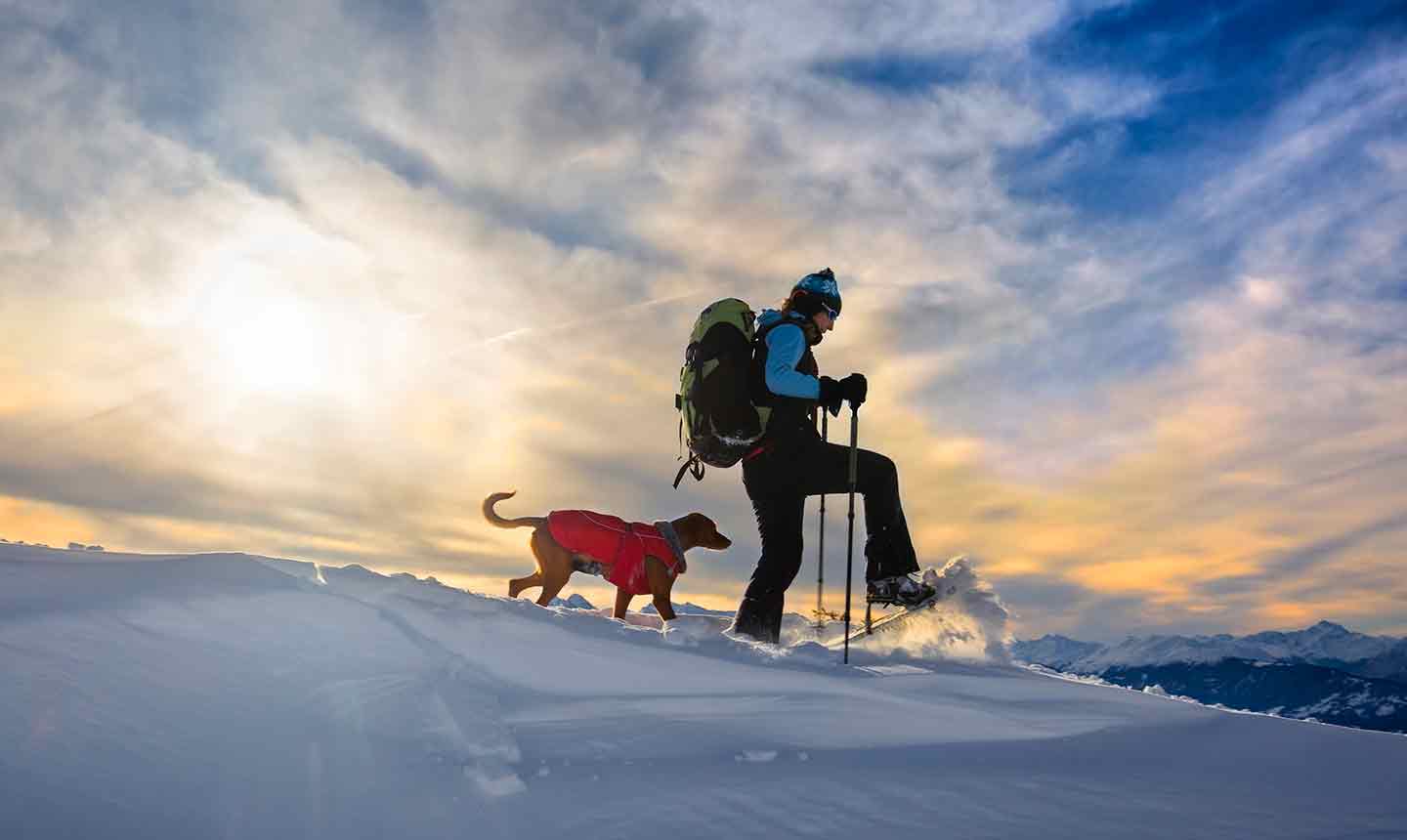
2 Snowshoeing
- Difficulty: 3 to 4 (moderately difficult, depending on terrain)
- Best for: Dogs who love long walks and exploring new places
If you’ve always wanted to explore the great outdoors in a pair of wide, tennis racket-esque snowshoes, we’ve got good news: Snowshoeing is a great winter activity for your dog, too! This sport involves hiking through the snow, so it’s great for pretty much any dog who’s safe to play in winter weather—just choose a terrain that matches your activity levels.
What You’ll Need
Snowshoes
Ski poles or trekking poles with snow baskets
Travel water bowl and water
Warm, waterproof boots
Warm but breathable layers
Water/snacks
Dog jacket (optional)
Extra layers
Dog booties (optional)
A small first-aid kit
How to Go Snowshoeing
To get started, you’ll need a pair of snowshoes, and the right ones for you will depend on the type of terrain and snow conditions typical of your location. Some outdoor gear companies offer snowshoe rentals so you can test them out in advance.
When choosing a location for snowshoeing with your dog, look for groomed trails or well-used routes that will have a packed-down path. Creating your own trail in fresh snow, while a great workout for you, won’t necessarily be as fun for your dog. Deep snow can also pose a hazard for dogs who can’t see what lies beneath the powder. And if you plan to go anywhere in the backcountry, always check current avalanche conditions.
While you’re out hiking with dogs in winter, keep a close eye on your dog’s energy levels. Bounding through the snow will take more effort than hiking on dry ground, so your dog likely won’t be able to go as far as they do in the summer. Scott Renbarger, hiking guide and owner of Outspire Hiking and Snowshoeing, says that most fit, active dogs are good for about one to two hours out in the snow. Pick a snowshoe route and distance that matches your dog’s fitness level.
Snowshoeing Tips:
- Check the area’s leash laws. If dogs are allowed off-leash, be sure your pup has solid recall and comes back to you on command. Winter trails are often shared with cross-country skiers, snowmobiles and other users, so your pup will need to stick close to you and be reliable when you call.
- Be sure to pick up after your dog.
3 Scent Tracking
- Difficulty: 2 (not very difficult)
- Best for: Smart dogs who enjoy puzzles and brain games
Scent tracking or nose work is one of those dog sports that utilizes both your dog's body and brain. And while this activity is available to you all year long, you can use the snow to add a new level of difficulty and surprise.
What You'll Need
Warm clothes
Favorite toys or treats to hide outside
Boots
Dog jacket (optional)
Gloves
Dog booties (optional)
How to Do Nose Work With Your Dog
Give your pup’s nose a workout by hiding some of their favorite treats or toys around the yard in the snow. Then, let your dog’s sniffer go to work! If your dog is new to scent tracking, start by hiding the treats or toys in easy-to-find places. You may need to provide some gentle nudging at first to help them find the goodies. Over time, increase the difficulty so that your put gets a new challenge in each session.
Scent tracking is a great way to strengthen the bond between you and your pup and to give them some mental stimulation while they get some exercise out in the snow, too. In fact, the National Association of Canine Scent Work has found that scent work boosts dogs’ confidence and releases pleasurable endorphins in their brains. Sure beats another lazy afternoon by the fireplace!
Scent Tracking Tips:
- Use your own yard for this game so your hidden treats don’t accidentally attract other inquisitive noses.
- If the weather is too cold to go outside, don’t fret—you can practice nose work inside too!
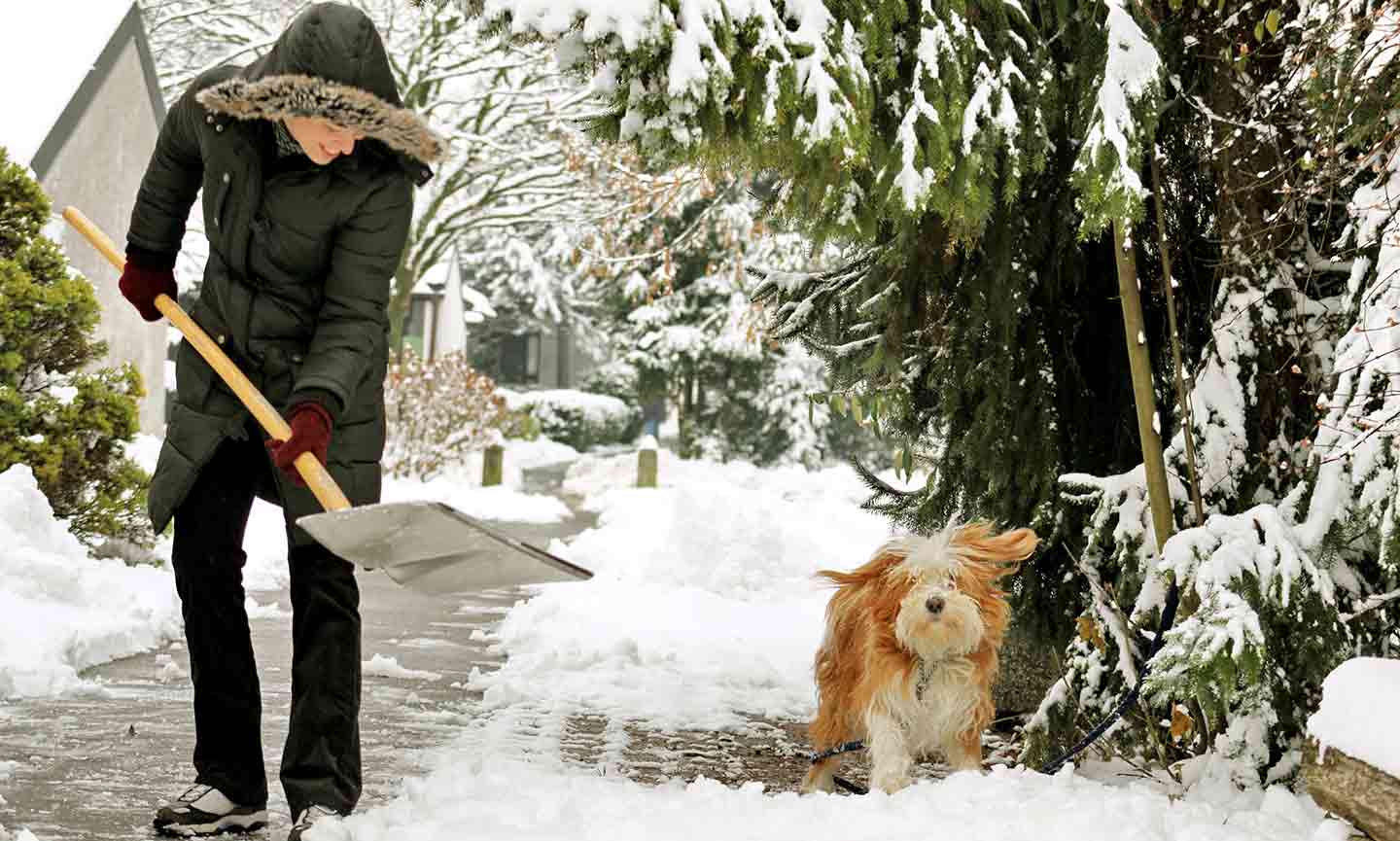
4 Build a Snow Maze
- Difficulty: 2 (easy)
- Best for: All winter weather-ready dogs
If you have a yard and at least a couple inches of snowfall, congrats: You’ve got everything you need to create a snow maze for your dog. Especially fun for small dogs, a snow maze is a way for your pup to explore the winter wonderland without having to blaze their own trails. You’ll get a good upper body workout while shoveling, too.
What You’ll Need
Warm clothes
Dog jacket (optional)
Boots
Dog booties (optional)
Gloves
Snow shovel
How to Build a Snow Maze
Start by shoveling a maze-like path through the snow, so that when your dog walks through it, there will be a ridge of snow on either side of them. (Depending on how much snow you have, the walls of the maze might even reach over their head!) You can make the maze as elaborate or simple as you’d like. Include a few dead-ends, turnarounds and other maze-like connections, and see what your dog does! For a bonus, add a few toys or treats in certain spots, get out the camera and let your dog go to town.
Snow Maze Tips:
- Depending on how deep the snow is, your dog may or may not grasp the concept of sticking to the maze. Don’t get frustrated if they take a shortcut or get off course—the goal here is to have fun, so embrace however they choose to explore your snowy labyrinth.
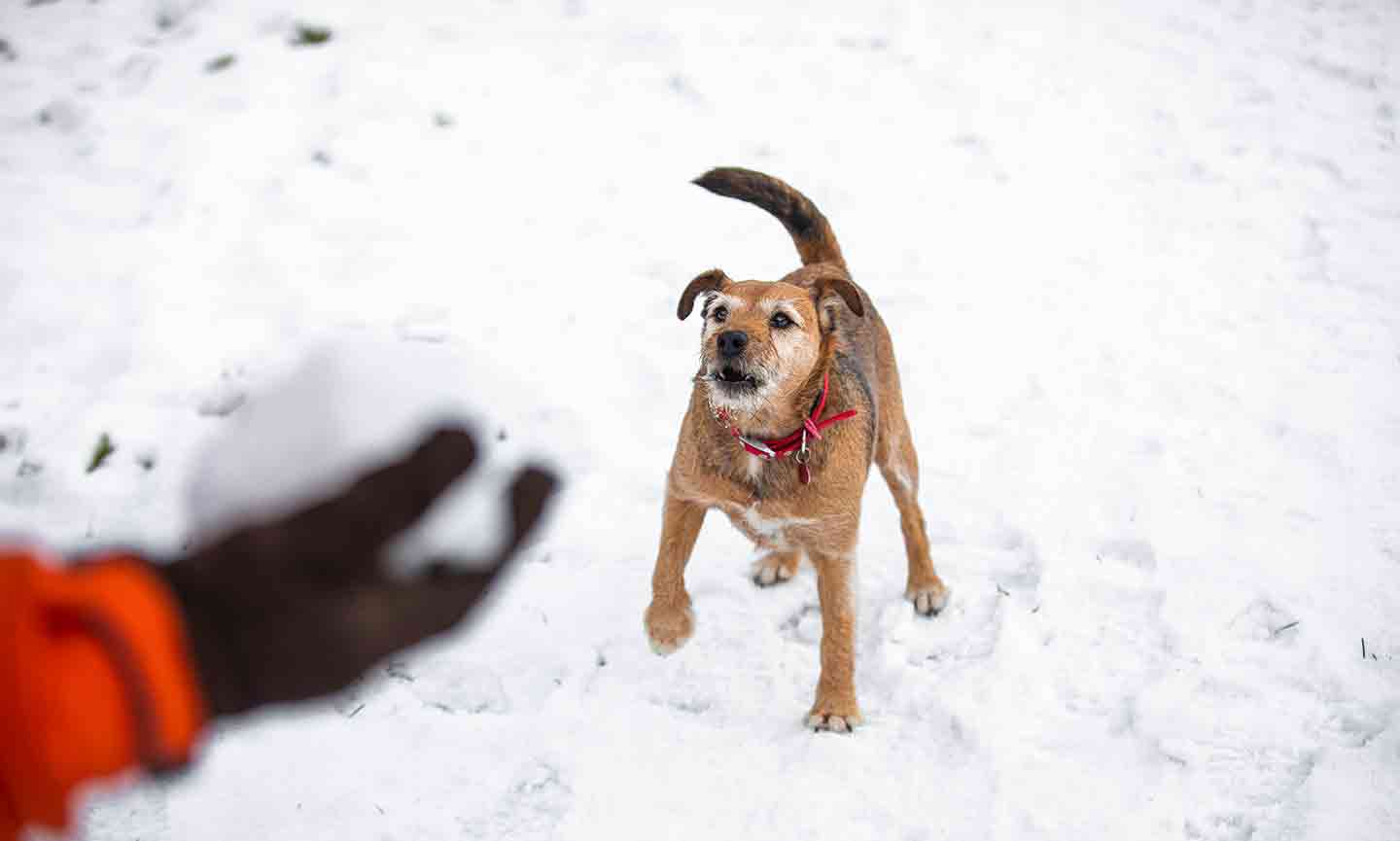
5 Play Snowball Catch
- Difficulty: 1
- Best for: Dogs who love chasing balls
If your dog loves playing fetch, a gentle game of snowball catch is a win-win: a fun winter activity for you and your dog that doesn’t require a long list of gear.
What You’ll Need
Warm clothes
Dog jacket (optional)
Boots
Dog booties (optional)
Gloves
Camera (get that slo-mo snowball snatching shot!)
How to Play Snowball Catch
As winter dog activities go, this might be the simplest: Just gently pack a fluffy snowball and give it a toss! Athletic pups will love leaping for the snowball or diving into the powder. Dogs who love chasing balls will enjoy running down the snowball. You’ll get some fresh air, and your dog will get to stretch their legs in this canine version of a classic snowball fight.
Snowball Catch Tips:
- Only toss light, fluffy snowballs made with clean snow. Be sure that the snowball isn’t dirty, hard, heavy, wet, slushy or icy to prevent hurting your dog’s jaw or teeth.
Share:





